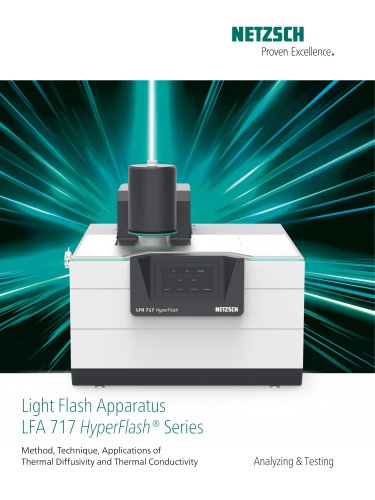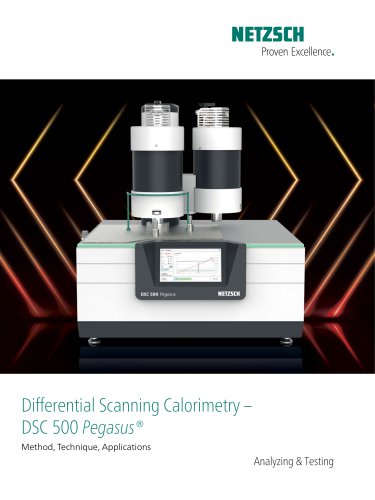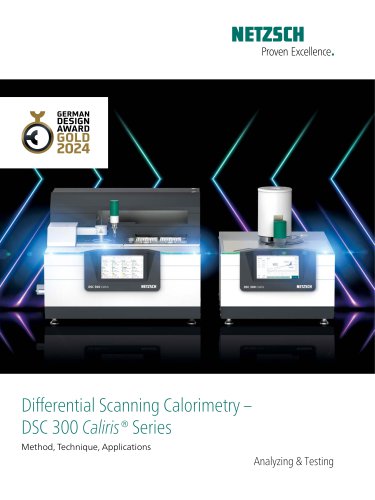 Website:
NETZSCH Analyzing & Testing
Website:
NETZSCH Analyzing & Testing
Group: NETZSCH
Catalog excerpts

TGA-GC-MS Coupling Evolved Gas Analysis with Chromatographic Pre-Separation Analyzing & Testing
Open the catalog to page 1
Thermogravimetry and Thermogravimetry (TGA) and Simultaneous Thermal Analysis (STA) Thermogravimetry (TGA) and Simultaneous Thermal Analysis (STA), which is primarily simultaneous TGA-DSC (Differential Scanning Calorimetry), are widely applied analytical methods for the research and quality control of all kinds of inorganic and organic materials and products. Often, it is not sufficient to determine only the mass and enthalpy changes resulting from a thermal treatment; additional information may be required about the volatile products evolved during chemical reactions, thermally induced...
Open the catalog to page 2
Evolved Gas Analysis Gas Chromatography (GC) – Mass Spectrometry (MS) GC is a high-resolution method for separating volatile and semivolatile compounds. The gas mixtures are separated based on the differences in component distribution between a stationary phase (e.g., inner coating of a capillary) and a mobile phase (purge gas; e.g., helium). Gas components with low affinity for the stationary phase but higher affinity for the mobile phase will be rapidly carried away by the purge gas, whereas gases with a high affinity for the stationary phase will follow with a relatively significant time...
Open the catalog to page 3
TGA/STA-GC-MS Coupling Since the gas separation in the GC column takes a certain amount of time – the duration of which depends upon sample characteristics, column flow rate, column length, and stationary and mobile phase – it is not possible to couple into the GC with a continuous online sample gas flow. Our solution, therefore, was to develop a direct coupling in a quasi-continuous mode using heated automatic valves, which allow for softwarecontrolled gas sampling (flow-through sampling loop) and gas injection, even at short intervals, within the NETZSCH Proteus® software. Sample...
Open the catalog to page 4
Valve Box The NETZSCH valve box contains a heated double loop system. Operation of the valve is completely controlled by the NETZSCH Proteus® software. This system allows either continuous injections (i.e., recurrent injections at defined intervals and with a definable number of occurrences) to the GC column or event-controlled injections. Maximum Flexibility To achieve a higher concentration in evolved gas species, an optional cooling trap can be placed between the injector system and the GC column. Additionally, it is also possible to directly inject the gas mix into the mass...
Open the catalog to page 5
TGA/STA-GC-MS Coupling Gas chromatography comes into play when MS has reached its limitations in determining the properties of complex gas mixtures. 4 Transfer line to the GC-MS Mass spectrometer Valve-based gas injector and temperature controller
Open the catalog to page 6
State-of-the-art Quadrupole-MS >1000 u High-speed sampling; up to 20000 u/s Various ionization techniques available (EI, CI, PI, depending on MS type) Tool-free servicing, e.g., simplified ion source maintenance Stand-alone MS measurements Transfer System Heated adapter system (up to 400°C) Heated transferline (max. 350 °C) with inert glass-lined steel capillary NETZSCH Box – Valve-Based Gas Injector Double-loop system for short injection intervals Software integrated in Proteus® Special insulation design for constant temperature (up to 350 °C) to prevent cold spots Easy GC integration via...
Open the catalog to page 7
THE THREE MEASUREMENT MODES QUASI-CONTINUOUS, EVENTCONTROLLED AND CRYO TRAP ARE EXPLAINED WITH THE HELP OF THE SAME MATERIAL: POLYCARBONATE (PC) 100 During the entire TGA run, the gases produced were sampled at intervals of 4 min in the GC column, which was kept at a constant temperature of 200°C. As soon as the mass loss started, the total ion current (TIC) detected several peaks. Analysis of the MS spectra for each injection gave a mixture of compounds released during pyrolysis. Eight different compounds were identified. Due to the increased temperature of the column, not all peaks were...
Open the catalog to page 8
Event-Controlled Mode One injection to the column was automatically conducted as soon as the DTG peak (peak in the first derivative of the TGA curve) was detected by the software. The GC column was heated from 40°C to 300°C at 5 K/min to separate the compound mixture. Nine compounds could clearly be identified. To do so, the mass spectra of each peak were compared to the NIST library. The identification of phenol is shown below as an example. Total ion chromatogram for polycarbonate measured in the event mode; peaks labeled with identified compounds. Name CO2 Phenol 4-Methylphenol...
Open the catalog to page 9
Multi-Injection and Cryo Trap Mode During the TGA measurement, the outer jacket of the cryo trap is cooled with liquid nitrogen to trap outgassing compounds (cooling phase, left image) to increase concentration. After the gas collection has completed, the trap is immediately heated with the built-in heating cartridge (heating phase, right image) at high heating rates to ensure sharp gas injection to the column. Column in Heating Cartridge Cooling Phase Heating Phase Gaseous coolant out in Liquid coolant Functional principle of the cryo trap In principle, the detection limit of by-products...
Open the catalog to page 10
Evaluation of the GC-MS-TIC Chromatograms TIC *106/Counts 1.080 min The GC-MS software enables easy evaluation of the mass spectra for each peak in the chromatogram. An easy zoom-in function allows for enlargement of the peaks. The NIST search generates a compound list including retention time, score and compound name. Each measured spectrum can be displayed in comparison to the NIST spectrum.
Open the catalog to page 11
This example shows a thermogravimetric measurement (TGA, green) on polystyrene with the event-controlled mode. One gas portion was injected on the column at the DTG peak (black) at 418°C. Separation of the compounds released over the GC column with a temperature ramp of 15 K/min yielded the three main compounds styrene, the styrene dimer and styrene trimer, which are in good correlation with literature data. Unlimited Applications TGA curve (green) for polystyrene (PS) under inert conditions; mass loss rate (DTG, black) Total ion chromatogram for polystyrene (PS), measured in the event...
Open the catalog to page 12All NETZSCH Analyzing & Testing catalogs and technical brochures
-
LFA 427 - product brochure
24 Pages
-
Kinexus Prime Series
20 Pages
-
Kinexus Prime DSR Series
20 Pages
-
LFA 717 HyperFlash® Series
28 Pages
-
Product Overview
12 Pages
-
DMA 303 Eplexor
24 Pages
-
DSC 300 Caliris Series
28 Pages
-
STA 509 Jupiter Series
28 Pages
-
TG 309 Libra Series
24 Pages
-
DEA 288 Ionic
20 Pages
-
STA 2500 Regulus
12 Pages
-
NTA Guarded Hot Plate Series
16 Pages
-
TMA 402 F1/F3 Hyperion®
16 Pages
-
Rosand Series
20 Pages
-
Accelerating Rate Calorimetry
20 Pages
-
NTA HotBoxes
16 Pages
-
DIL 402 Expedis Select/Supreme
28 Pages
-
DIL 402 Expedis Classic
16 Pages
-
NETZSCH Energy Solutions
40 Pages
-
Advanced Materials Testing
32 Pages
-
NTA Fire Testing Systems
20 Pages
-
Kinetics NEO
20 Pages
-
TG-FTIR - product brochure
24 Pages
-
TA-QMS Coupling
28 Pages
-
HMOR 422
1 Pages
-
RUL/CIC 421
1 Pages
-
Cone Calorimeter TCC 918
12 Pages
-
Thermal Insulation Materials
24 Pages
-
SBA 458 Nemesis®
24 Pages
-
NETZSCH NEVIO Instrument Series
24 Pages
-
DMA GABO EPLEXOR up to 1500°C
12 Pages
-
GABOMETER®
8 Pages


























































